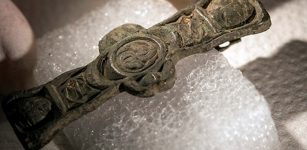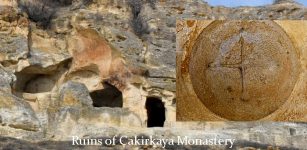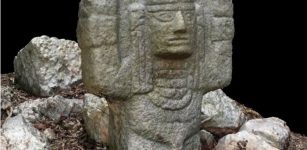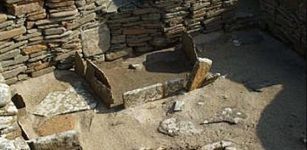Cosquer Cave And Its Magnificent Underwater Stone Age Paintings Created 27,000 Years Ago
Ellen Lloyd - AncientPages.com - Cosquer Cave is the world's only underwater Stone Age cave and a marvelous place where archaeologists have discovered mysterious paintings created by our long-gone ancestors.
Located in the Calanque de Morgiou in Marseille, France, the underwater Cosquer Cave is home to 500 extraordinary paintings and engravings. The cave drawings were made during two epochs of occupation in this part of the world. The first paintings were created 27,000 years ago; later, 19,000 years ago, cave artists produced more beautiful drawings on the walls.
The Cosquer Cave's rock art. Credit: Image compilation by AncientPages.com - original images by Archeologie Culture France.
Exploring the cave is difficult because there is only one entrance through a narrow underwater tunnel 40 meters below sea level.
The Cosquer Cave "art was preserved because the chamber happened to be high up enough not to have been flooded, but large numbers of paintings and engravings were most probably destroyed in the passage and in the lower part of the chamber.
Many other caves along that coast disappeared under the sea after the end of the Pleistocene with the rise of the water, but it is the first time ever that rock art was discovered under such circumstances." 1
The cave was accidentally discovered in 1985 by a professional Scuba diver named Henri Cosquer. Cosquer quickly understood he had found something extraordinary and kept his discovery secret for some years. Fearing the unique, ancient, underwater cave paintings would be destroyed, he only told archaeologist Jean Clotte about his discovery. The two men kept knowledge of Cosquer Cave secret for six years. Later, when the French government learned about this important archaeological and historical place, they revealed the information to the public.
Cosquer Cave Is The Only Underwater Stone Age Cave
The rock art in Cosquer Cave provided scientists with knowledge about how European Stone Age people perceived their surroundings.
Some newspapers questioned the authenticity of the paintings and engravings in the Cosquer Cave. Still, scientists later confirmed these were original drawings made by Stone Age people.
Being the only underwater Stone Age cave known to date, Cosquer Cave offers a unique glimpse into the past.
Credit: Archeologie Culture France.
The prehistoric Cosquer Cave is today a protected area open only to researchers. Nevertheless, it is naturally possible to learn what kind of paintings and engravings scientists have discovered in this submerged Stone Age realm.
"At least half the paintings are covered with patches of bright white calcite, of a type which, according to geologists, takes a very long time in depositing." 1
There are numerous paintings of different animals and engravings of hands on the cave walls.
In 1992 scientists were aware of "44 animals (21 engraved, 23 painted) and 26 negative hands, most of them with incomplete fingers, have been found. Horses are dominant (14), followed by bisons and ibex in equal numbers (7), then by chamois (5); there also are 1 red deer, 1 feline, 3 penguins, 2 seals and 2 possible megaceros, as well as 2 indeterminate quadrupeds.
Many signs, among which long barbed lines superimposed on various animals, were observed. In addition, the walls of the chamber are covered with innumerable fine engravings and finger tracings that have not so far been studied. The present count of animals, hands and signs is therefore highly provisional. The superimpositions point to two possible periods, the earlier with the negative hands and the finger tracings, the later with the painted and engraved animals and the fine engravings. "2
Today, researchers have documented as many as 500 paintings and engraving on the cave's walls.
Can Cosquer Cave's Prehistoric Rock Art Be Saved?
Scientists think it may take years before the importance of this discovery is obvious. The cave is located in a region "where no Paleolithic rock art had ever been found before." 1
According to experts, the paintings found in the Cosquer Cave exhibit various characteristics that may bear witness to outside influences.
One such place could be the Lascaux Caverns, "world-renowned for their Magdalenian paintings." 2
A replica of the Cosquer Cave is currently being created by scientists. Credit: Grotte Cosquer
Maybe there was an ancient connection between the Lascaux and Cosquer Cave painters, but each cave features its unique rock art.
Cosquer Cave's rock art has withstood the test of time, but experts warn the paintings and engravings may soon be destroyed due to climate change. We do not know if this will happen any time soon, and there is no need to panic. After all, the Cosquer Cave's rock art has survived for 27,000 years, but the future is uncertain.
To preserve the memory of our ancient ancestors and give future generations the to admire this beautiful Stone Age art, scientists and specialists are currently building a replica of the Cosquer Cave for a maritime museum in Marseille.
Updated on December 15, 2023
Written by Ellen Lloyd - AncientPages.com
Copyright © AncientPages.com All rights reserved. This material may not be published, broadcast, rewritten or redistributed in whole or part without the express written permission of AncientPages.com
Expand for references- Clottes, J., A. Beltrán, J. Courtin, and H. Cosquer. "La Grotte Cosquer (Cap Morgiou, Marseille)." Bulletin De La Société Préhistorique Française89, no. 4 (1992): 98-128.
- Clottes J. & Courtin J - The Cave Beneath the Sea
More From Ancient Pages
-
 Witch Of Endor – A Biblical Ghost Story Or A Woman With Supernatural Powers?
Biblical Mysteries | Jul 9, 2021
Witch Of Endor – A Biblical Ghost Story Or A Woman With Supernatural Powers?
Biblical Mysteries | Jul 9, 2021 -
 Roman Square Capitals: Prestigious Script That Delighted Human Eye With Its Elegance
Featured Stories | Sep 16, 2019
Roman Square Capitals: Prestigious Script That Delighted Human Eye With Its Elegance
Featured Stories | Sep 16, 2019 -
 European Neolithic Family Trees Shed Light On Social Organization
Archaeology | Jul 27, 2023
European Neolithic Family Trees Shed Light On Social Organization
Archaeology | Jul 27, 2023 -
 Table Manners And First Code Of Correct Behavior Were Introduced In Egypt 2,500 B.C. By Ptahhotep
Ancient History Facts | Oct 26, 2020
Table Manners And First Code Of Correct Behavior Were Introduced In Egypt 2,500 B.C. By Ptahhotep
Ancient History Facts | Oct 26, 2020 -
 Denisovan Family Tree: New Branches Revealed In Ancient DNA
Archaeology | Apr 12, 2019
Denisovan Family Tree: New Branches Revealed In Ancient DNA
Archaeology | Apr 12, 2019 -
 Medieval Irish Book Fitting Among Historical Finds Unearthed In Old Cemetery In Norway
Archaeology | Dec 15, 2017
Medieval Irish Book Fitting Among Historical Finds Unearthed In Old Cemetery In Norway
Archaeology | Dec 15, 2017 -
 Rohonczi Codex Still Undeciphered – Is It The Most Secret Book Written In A Code?
Artifacts | May 30, 2014
Rohonczi Codex Still Undeciphered – Is It The Most Secret Book Written In A Code?
Artifacts | May 30, 2014 -
 King Ur-Nammu – King Of Ur, King Of Sumer And Akkad – The One Who Built The Temple Of God Enlil
Ancient History Facts | Aug 30, 2015
King Ur-Nammu – King Of Ur, King Of Sumer And Akkad – The One Who Built The Temple Of God Enlil
Ancient History Facts | Aug 30, 2015 -
 Rock-Carved Turkey’s Çakırkaya Monastery Dated To 13th Century Will Be Restored
Archaeology | Mar 18, 2020
Rock-Carved Turkey’s Çakırkaya Monastery Dated To 13th Century Will Be Restored
Archaeology | Mar 18, 2020 -
 America’s Native Population Arises From A Single Wave Of Asian Migration – Dental Anthropologists Say
Archaeology | Dec 19, 2023
America’s Native Population Arises From A Single Wave Of Asian Migration – Dental Anthropologists Say
Archaeology | Dec 19, 2023 -
 Bizarre Towering Pillars Of Externsteine: Myths, Legends And Sacred Rituals From Times Long Gone
Civilizations | Jan 7, 2017
Bizarre Towering Pillars Of Externsteine: Myths, Legends And Sacred Rituals From Times Long Gone
Civilizations | Jan 7, 2017 -
 The Black Obelisk Of Shalmaneser III – Great Assyrian Ruler
Artifacts | Dec 29, 2016
The Black Obelisk Of Shalmaneser III – Great Assyrian Ruler
Artifacts | Dec 29, 2016 -
 Ancient Atlantean Sculpture Discovered At The Mayan Chichen Itza Archaeological Site
Archaeology | Aug 29, 2023
Ancient Atlantean Sculpture Discovered At The Mayan Chichen Itza Archaeological Site
Archaeology | Aug 29, 2023 -
 Mystery Of Pre-Adamic Didanum Race: Giants Who Were Ancestors Of The Nephilim and Rephaim
Biblical Mysteries | Oct 2, 2014
Mystery Of Pre-Adamic Didanum Race: Giants Who Were Ancestors Of The Nephilim and Rephaim
Biblical Mysteries | Oct 2, 2014 -
 On This Day In History: Scottish Hero William Wallace Who Met Horrible Death – Is Still Remembered – August 23, 1305
News | Aug 23, 2016
On This Day In History: Scottish Hero William Wallace Who Met Horrible Death – Is Still Remembered – August 23, 1305
News | Aug 23, 2016 -
 Female Viking Pirate Rusla – The Red Maiden’s Deadly Encounter With Her Brother Tesondus
Featured Stories | Jul 2, 2019
Female Viking Pirate Rusla – The Red Maiden’s Deadly Encounter With Her Brother Tesondus
Featured Stories | Jul 2, 2019 -
 Did The Biblical Magi Bring Jesus Gifts With Healing Properties?
Biblical Mysteries | Dec 24, 2017
Did The Biblical Magi Bring Jesus Gifts With Healing Properties?
Biblical Mysteries | Dec 24, 2017 -
 A Rare Pre-Roman Tomb Unearthed In Pompeii
News | Sep 22, 2015
A Rare Pre-Roman Tomb Unearthed In Pompeii
News | Sep 22, 2015 -
 First Bathrooms Appeared Around 8,000 B.C In Scotland
Ancient History Facts | Dec 11, 2016
First Bathrooms Appeared Around 8,000 B.C In Scotland
Ancient History Facts | Dec 11, 2016 -
 Gigantic Asipatra: Terrifying Mythical Monster Bird In Hindu Beliefs
Featured Stories | Jun 14, 2017
Gigantic Asipatra: Terrifying Mythical Monster Bird In Hindu Beliefs
Featured Stories | Jun 14, 2017



